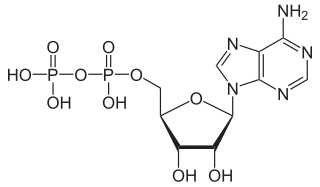
Adenosine diphosphate (ADP), also known as adenosine pyrophosphate (APP), is an important organic compound in metabolism and is essential to the flow of energy in living cells. ADP consists of three important structural components: a sugar backbone attached to adenine and two phosphate groups bonded to the 5 carbon atom of ribose. The diphosphate group of ADP is attached to the 5’ carbon of the sugar backbone, while the adenine attaches to the 1’ carbon.
Hydrolase is a class of enzymes that commonly perform as biochemical catalysts that use water to break a chemical bond, which typically results in dividing a larger molecule into smaller molecules. Some common examples of hydrolase enzymes are esterases including lipases, phosphatases, glycosidases, peptidases, and nucleosidases.
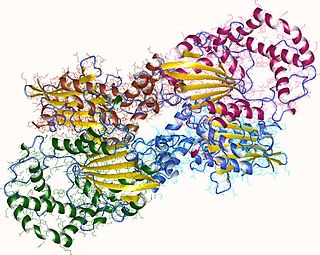
Acid phosphatase is an enzyme that frees attached phosphoryl groups from other molecules during digestion. It can be further classified as a phosphomonoesterase. It is stored in lysosomes and functions when these fuse with endosomes, which are acidified while they function; therefore, it has an acid pH optimum. This enzyme is present in many animal and plant species.
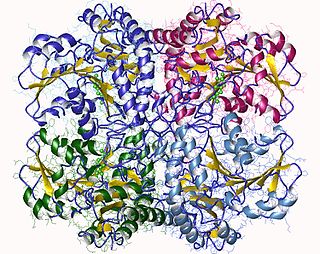
The enzyme cystathionine γ-lyase (EC 4.4.1.1, CTH or CSE; also cystathionase; systematic name L-cystathionine cysteine-lyase (deaminating; 2-oxobutanoate-forming)) breaks down cystathionine into cysteine, 2-oxobutanoate (α-ketobutyrate), and ammonia:

In enzymology, a phosphoenolpyruvate mutase is an enzyme that catalyzes the chemical reaction
In enzymology, an acylpyruvate hydrolase (EC 3.7.1.5) is an enzyme that catalyzes the chemical reaction
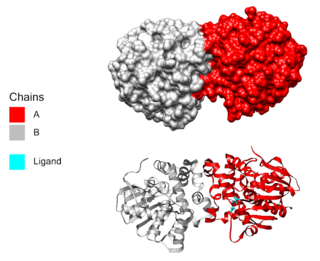
In enzymology, a haloacetate dehalogenase (EC 3.8.1.3) is an enzyme that catalyzes the chemical reaction
In enzymology, a phosphonoacetaldehyde hydrolase (EC 3.11.1.1) is an enzyme that catalyzes the chemical reaction

In enzymology, a phosphonoacetate hydrolase (EC 3.11.1.2) is an enzyme that catalyzes the chemical reaction
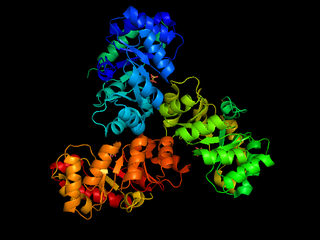
The enzyme 2-dehydro-3-deoxy-phosphogluconate aldolase, commonly known as KDPG aldolase, catalyzes the chemical reaction

In enzymology, an acylphosphatase (EC 3.6.1.7) is an enzyme that catalyzes the hydrolysis of the carboxyl-phosphate bond of acylphosphates, with acylphosphate and H2O as the two substrates of this enzyme, and carboxylate and phosphate as its two products:

ADP-ribose diphosphatase (EC 3.6.1.13) is an enzyme that catalyzes a hydrolysis reaction in which water nucleophilically attacks ADP-ribose to produce AMP and D-ribose 5-phosphate. Enzyme hydrolysis occurs by the breakage of a phosphoanhydride bond and is dependent on Mg2+ ions that are held in complex by the enzyme.
In enzymology, a m7G(5')pppN diphosphatase (EC 3.6.1.30) is an enzyme that catalyzes the chemical reaction
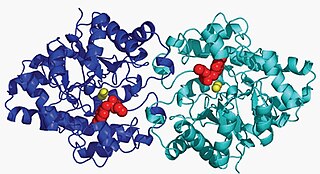
Aryldialkylphosphatase is a metalloenzyme that hydrolyzes the triester linkage found in organophosphate insecticides:
The enzyme [pyruvate dehydrogenase (acetyl-transferring)]-phosphatase (EC 3.1.3.43) catalyzes the reaction
The enzyme [pyruvate kinase]-phosphatase (EC 3.1.3.49) catalyzes the reaction
In enzymology, an adenosine-phosphate deaminase (EC 3.5.4.17) is an enzyme that catalyzes the chemical reaction
In enzymology, a choloylglycine hydrolase (EC 3.5.1.24) is an enzyme that catalyzes the chemical reaction

Pyruvate, phosphate dikinase, or PPDK is an enzyme in the family of transferases that catalyzes the chemical reaction
Acireductone synthase (EC number 3.1.3.77, E1, E-1 enolase-phosphatase) is an enzyme with systematic name 5-(methylsulfanyl)-2,3-dioxopentyl-phosphate phosphohydrolase (isomerizing). It catalyses the following reaction:











